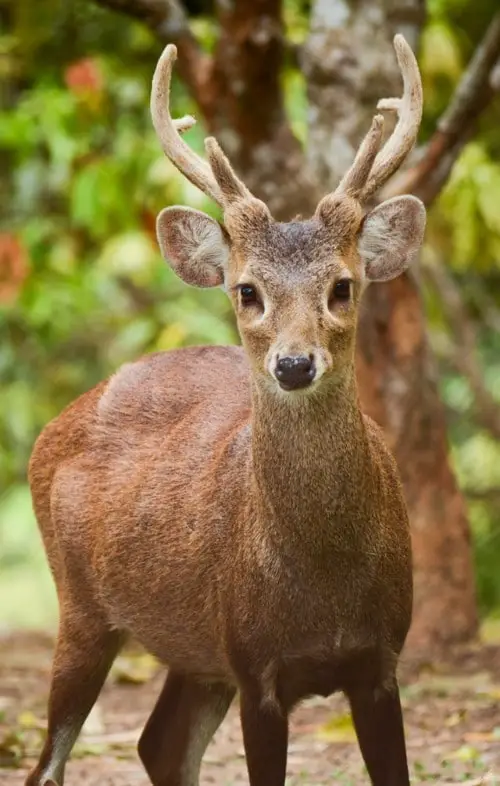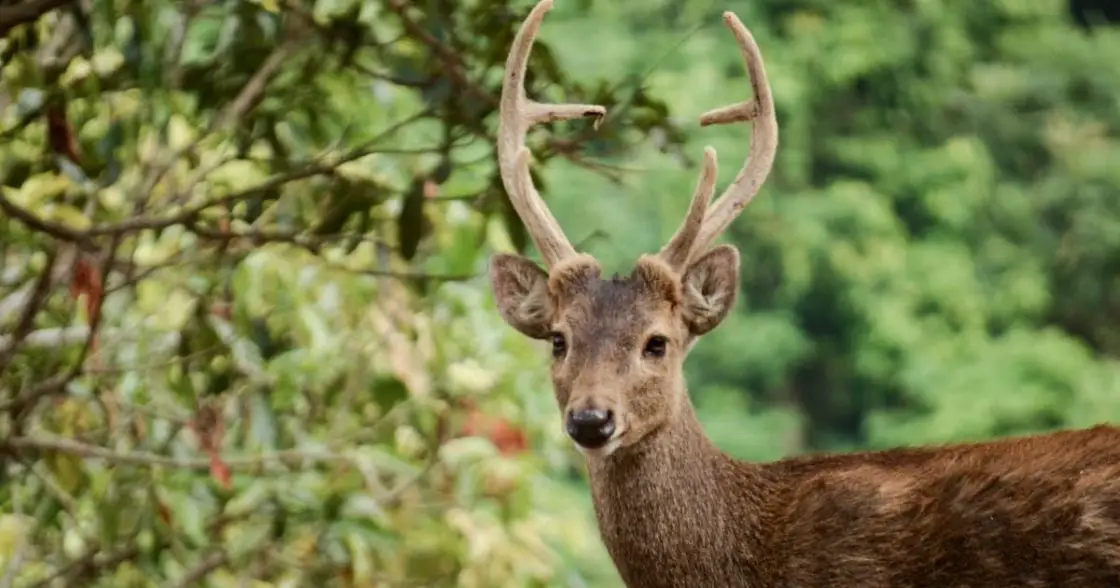The Bawean Deer (Hyelaphus kuhlii) is also commonly referred to as Kuhl’s Deer or the Bawean Hog Deer. This species is very threatened, and can only be found on a single island in Indonesia.
Bawean Deer Appearance
The Bawean or Kuhl’s deer is very similar in appearance to the Hog Deer.
Many scientists consider it to be a subspecies of the Hog Deer rather than a separate species. The main difference between it and the Indian Hog Deer are that it has a smaller head. The legs are also shorter in length.
Kuhl’s Deer have a dark brown coat with white markings underneath its chin and throat.

The tail is long and bushy with a white underside.
The antlers on Hyelaphus kuhlii are similar to those seen in the Hog Deer and typically have three tines. The Bawean Hog Deer’s antlers do not grow as long as those of the Indian Hog Deer.
Range & Habitat
Hyelaphus kuhlii are found only on the Indonesian island of Bawean where they have a small population. They are threatened because of habitat loss, and the forests they live in are rapidly disappearing as residents of their island clear woodlands to make way for new farms.
Mating Behavior in Hyelaphus kuhlii
Socially, they are known for their generally solitary nature, with females and males coming together only during the breeding season, a behavior also observed in other species as explained in this deep dive into deer mating habits.
Rutting takes place between September and October for this type of deer, and a single calf is born after a gestation period of 180 to 200 days (typically the following April or May).
The Bawean Deer exhibits unique breeding behaviors that are tied closely to its habitat’s climatic conditions. Typically, the mating season occurs once a year, and like many other deer species, bucks become more active in seeking out does during this period.
Females usually give birth to a single fawn after a gestation period of around 7 months. The fawns are born well-developed and are able to stand and follow their mothers shortly after birth. This rapid development is necessary for survival in the wild, as it allows the young deer to escape potential predators more effectively.
Habits & Behavior
The Bawean Deer is a shy secretive creature, which is nocturnal in habit. It lives alone for most of the year and tends not to like to group as part of a herd, but you can sometimes observe Hyelaphus kuhlii traveling and living in pairs.
Conservation Status
Classified as endangered by the International Union for Conservation of Nature (IUCN), the Bawean Deer faces several threats, including habitat loss, illegal hunting, and competition with domestic livestock for food.
Due to their confined geographical range and small population size, the Bawean Deer’s situation is particularly precarious, which makes conservation efforts crucial for their survival.
Efforts to Protect the Bawean Deer
Conservation initiatives have been put in place to monitor and protect the Bawean Deer’s dwindling numbers. These include habitat restoration, anti-poaching patrols, and education programs aimed at local communities on the importance of preserving this unique species.
A significant part of conservation also includes responsible tourism that respects the deer’s habitat while allowing people to appreciate the species in the wild.
Potential for Eco-tourism
Eco-tourism can play a vital role in the conservation of the Bawean Deer by providing a sustainable income source for local communities. By promoting responsible wildlife viewing experiences, tourists can contribute to the economy, incentivizing the protection of the Bawean Deer and its natural habitat.
It’s essential, however, that such initiatives carefully manage the human-deer interactions to ensure they do not negatively impact the species.
Frequently Asked Questions About the Bawean Deer
What makes the Bawean Deer unique compared to other deer species?
Its limited distribution to a small island, specific habitat requirements, and nocturnal behaviors make the Bawean Deer distinctive.
Why is the Bawean Deer endangered?
Habitat destruction, poaching, and competition with domestic animals are the primary reasons for its endangered status.
How can I help in the conservation of the Bawean Deer?
Supporting accredited conservation programs and promoting awareness are effective ways to contribute to the protection of the Bawean Deer.


